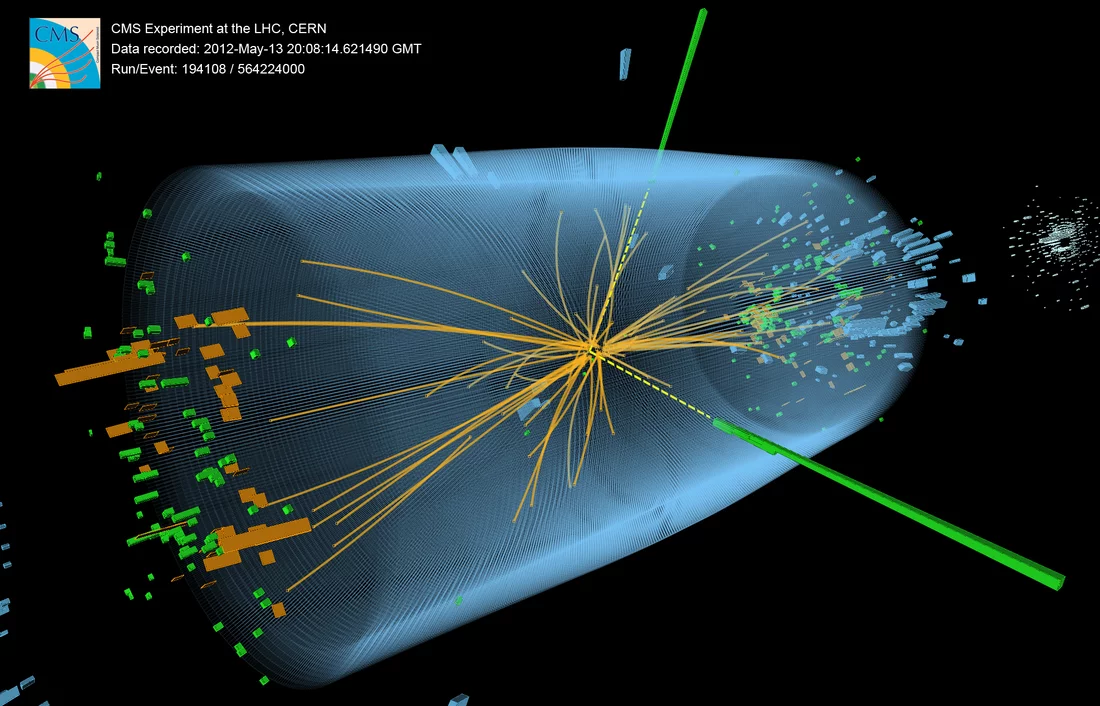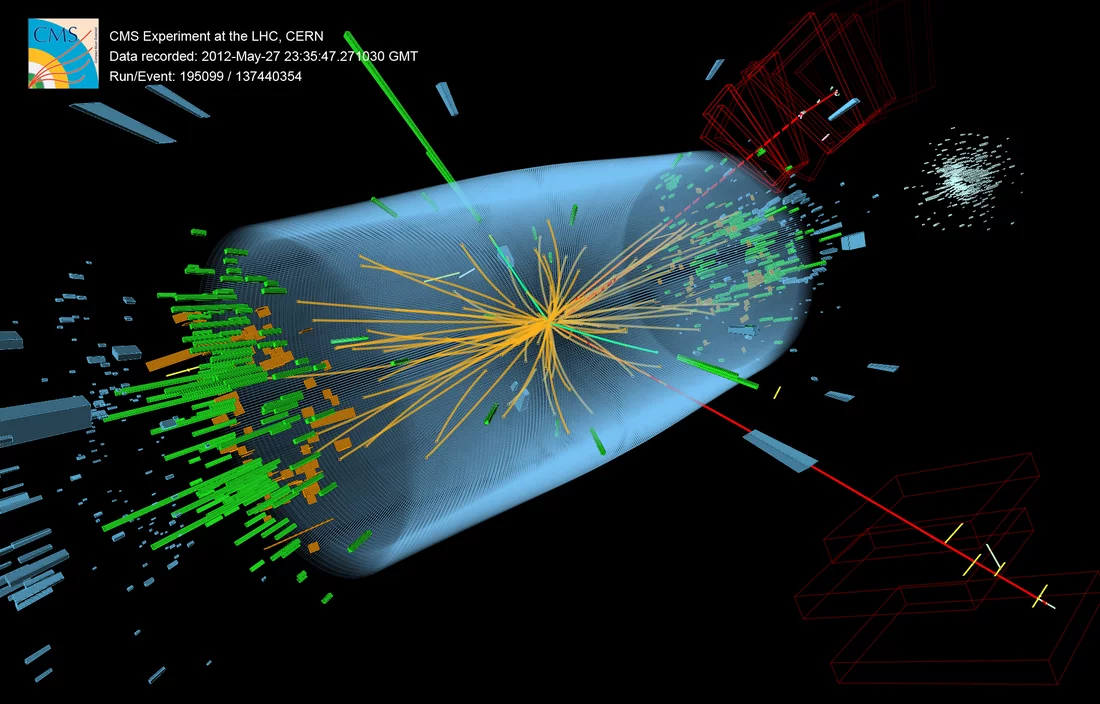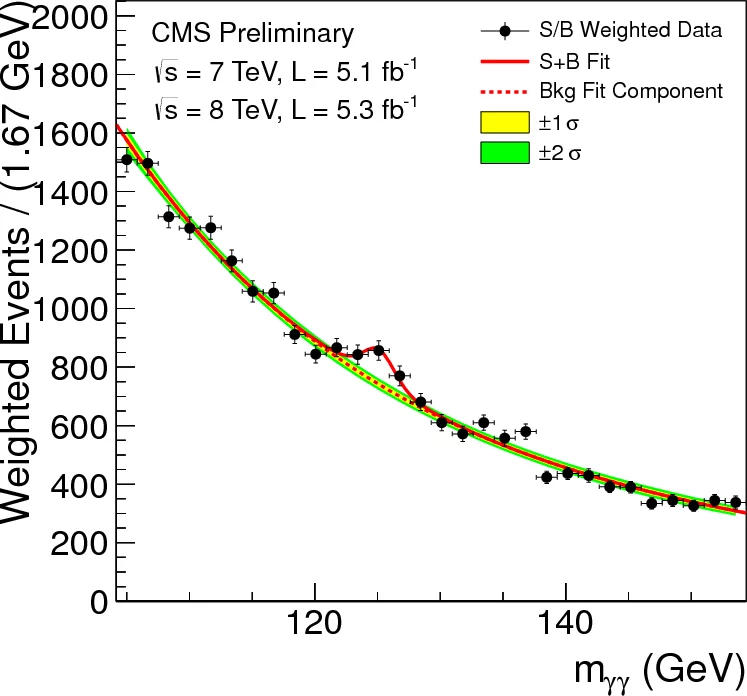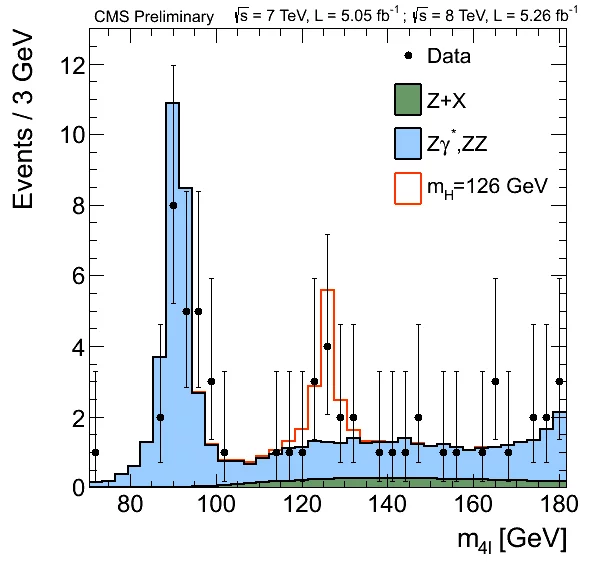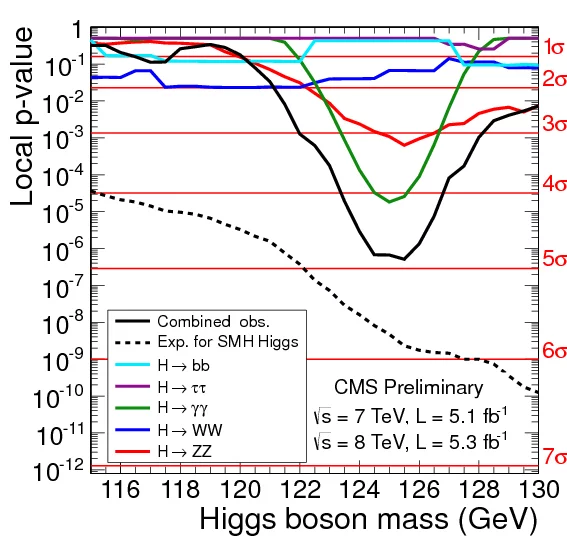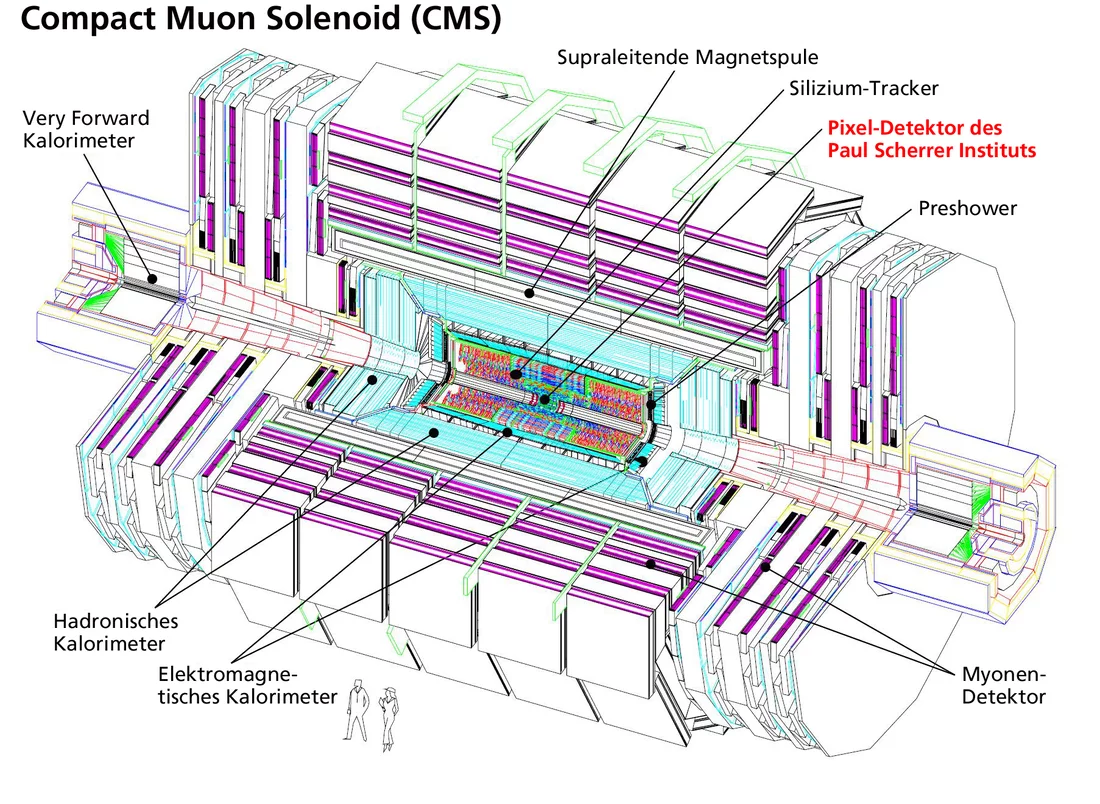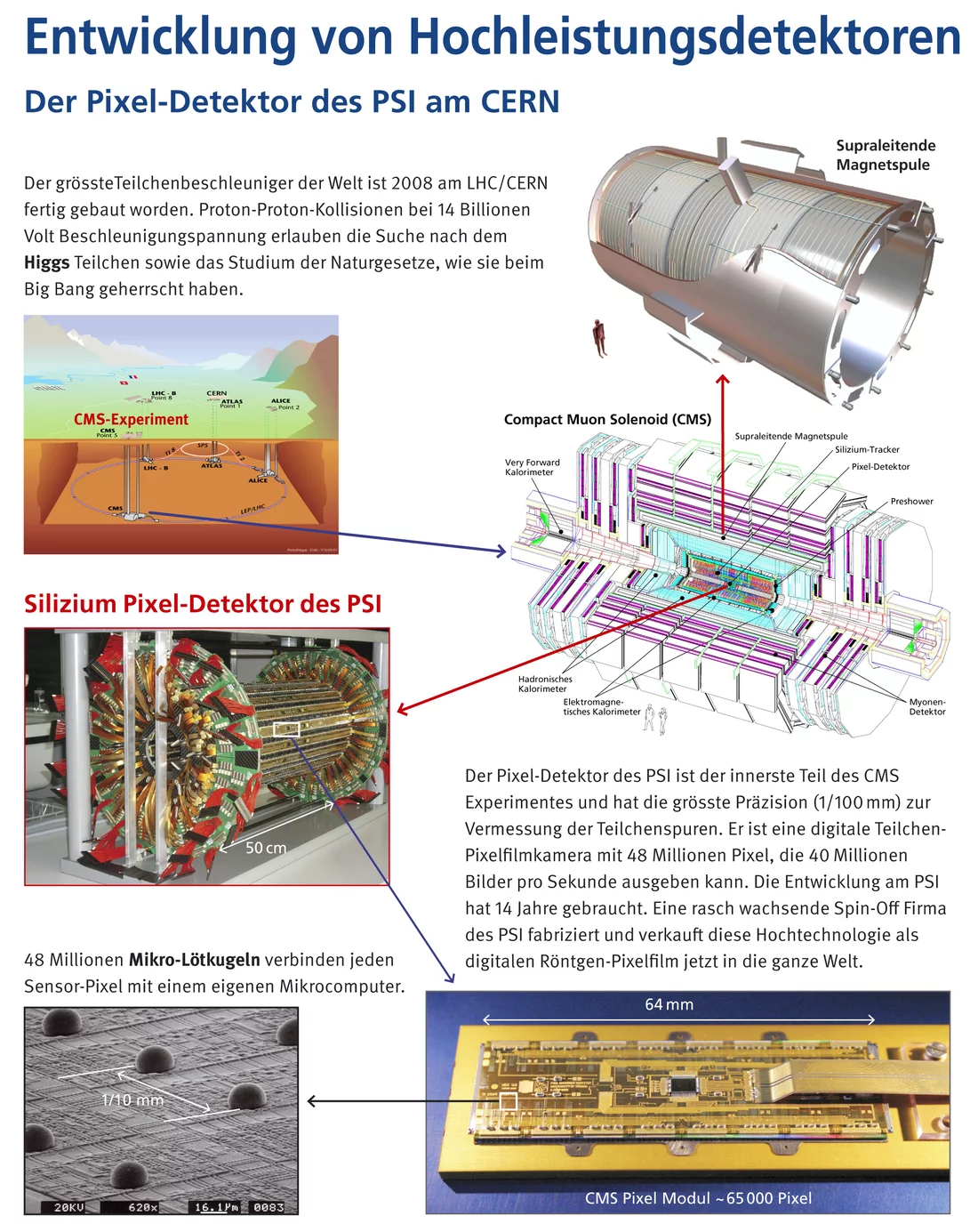In a joint seminar today at CERN and the ICHEP 2012 conference[1] in Melbourne, researchers of the Compact Muon Solenoid (CMS) experiment at the Large Hadron Collider (LHC) presented their preliminary results on the search for the standard model (SM) Higgs boson in their data recorded up to June 2012. The CMS collaboration contains a strong group of physicists from the PSI laboratory for particle physics. CMS observes an excess of events at a mass of approximately 125 GeV[2] with a statistical significance of five standard deviations (5 sigma)[3] above background expectations. The probability of the background alone fluctuating up by this amount or more is about one in three million. The evidence is strongest in the two final states with the best mass resolution: first the two-photon final state and second the final state with two pairs of charged leptons (electrons or muons). We interpret this to be due to the production of a previously unobserved particle with a mass of around 125 GeV.
This text has been kindly provided by CMS communication officer Lucas Taylor
The CMS data also rule out the existence of the SM Higgs boson in the ranges 110-122.5 GeV and 127-600 GeV with 95% confidence level[4] – lower masses were already excluded by CERN’s LEP collider at the same confidence level. Within the statistical and systematic uncertainties, results obtained in the various search channels are consistent with the expectations for the SM Higgs boson. However, more data are needed to establish whether this new particle has all the properties of the SM Higgs boson or whether some do not match, implying new physics beyond the standard model. The LHC continues to deliver new data at an impressive rate. By the end of 2012, CMS hopes to have more than triple its total current data sample. These data will enable CMS to elucidate further the nature of this newly observed particle. They will also allow CMS to extend the reach of their many other searches for new physics.
CMS Search Strategy
CMS analysed the full data sample of proton-proton collisions collected in all of 2011 and in 2012, up until June 18. These data amount to up to 5.1 fb-1 of integrated luminosity[5], at a centre-of-mass energy of 7 TeV in 2011 and up to 5.3 fb-1 at 8 TeV in 2012. The standard model predicts that the Higgs boson lasts for only a very short time before it breaks up, or “decays”, into other well-known particles. CMS studied five main Higgs boson decay channels. Three channels result in pairs of bosonic particles (γγ, ZZ or WW) and two channels result in pairs of fermionic particles (bb or ττ), where γ denotes a photon, Z and W denote the force carriers of the weak interaction, b denotes a bottom quark, and τ denotes a tau lepton. The γγ, ZZ and WW channels are equally sensitive in the search for a Higgs boson around 125 GeV and all are more sensitive than the bb and ττ channels. The γγ and ZZ channels are especially important as they both allow the mass of the new particle to be measured with precision. In the γγ channel the mass is determined from the energies and directions of two high-energy photons measured by the CMS crystal electromagnetic calorimeter (ECAL, Figure 1). In the ZZ channel the mass is determined from the decays of the two Zs to two pairs of electrons, or two pairs of muons, or a pair of electrons and a pair of muons (Figure 2). These are measured in the ECAL, inner tracking and muon detectors.
The WW channel is more complex. Each W is identified through its decay to an electron and a neutrino or a muon and a neutrino. The neutrinos pass through the CMS detectors undetected, so the SM Higgs boson in the WW channel would manifest itself as a broad excess in the mass distribution, rather than a narrow peak. The bb channel has large backgrounds from standard model processes, so the analysis searches for events in which a Higgs boson is produced in association with a W or Z, which then decays to electron(s) or muon(s). The ττ channel is measured by observing τ decays to electrons, muons and hadrons.
CMS Results Summary
The CMS data sample should be sensitive enough to completely exclude the mass range 110–600 GeV at 95% confidence level, if the SM Higgs does not exist. In fact, the CMS data do rule out the existence of the SM Higgs boson in two broad mass ranges of 110–122.5 GeV and 127–600 GeV with 95% confidence level. The range of 122.5–127 GeV cannot be excluded because we see an excess of events in three of the five channels analysed:
- γγ channel: the γγ mass distribution is shown in Figure 3. There is an excess of events above background with a significance of 4.1 sigma, at a mass near 125 GeV. The observation of the two-photon final state implies that the new particle is a boson, not a fermion, and that it cannot be a “spin 1” particle.
- ZZ channel: Figure 4 shows the mass distribution for the four leptons (two pairs of electrons, or two pairs of muons, or the pair of electrons and the pair of muons). Accounting also for the decay angle characteristics, it yields an excess of 3.2 sigma above background at a mass near 125 GeV.
- WW channel: a broad excess in the mass distribution of 1.5 sigma is observed.
- bb and ττ channels: no excess is observed.
The statistical significance of the signal, from a combined fit to all five channels (Figure 5), is 4.9 sigma above background. A combined fit to just the two most sensitive and high-resolution channels (γγ and ZZ) yields a statistical significance of 5.0 sigma. The probability of the background alone fluctuating up by this amount or more is about one in three million.
The mass of the new particle is determined to be 125.3 +/- 0.6 GeV, independent of any assumptions about the expected relative yields of the decay channels. The measured production rate (σDAT) of this new particle is consistent with the predicted rate (σSM) for the SM Higgs boson: σDAT/σSM = 0.80 +/- 0.22. Great care has also been taken to understand numerous details of the detector performance, the event selection, background determinations and other possible sources of systematic and statistical uncertainties. The 2011 analysis[6] showed an excess of events at about 125 GeV. Therefore, to avoid a potential bias in the choice of selection criteria for the 2012 data that might artificially enhance this excess, the 2012 data analysis was performed blind
[7], meaning that the region of interest was not examined until after all the analysis criteria had been fully scrutinized and approved. As a general cross-check, the analyses were performed by at least two independent teams. A number of other features reinforce confidence in the results:
- The excess is seen at around 125 GeV in both the 2011 data sample (7 TeV) and the 2012 data sample (8 TeV);
- The excess is seen at the same mass in both the high-resolution channels (γγ and ZZ);
- The excess seen in the WW is consistent with one that would arise from a particle at 125 GeV;
- The excess is seen in a range of final states involving photons, electrons, muons and hadrons.
The preliminary results presented today will be refined, with the aim of submitting them for publication towards the end of the summer.
Future plans
The new particle observed at about 125 GeV is compatible, within the limited statistical accuracy, with being due to the SM Higgs boson. However, more data are required to measure its properties such as decay rates in the various channels (γγ, ZZ, WW, bb and ττ) and ultimately its spin and parity, and hence ascertain whether it is indeed the SM Higgs boson or the result of new physics beyond the standard model. The LHC continues to perform extremely well. By the end of 2012, CMS expects to more than triple its total data sample, and hence to probe further the nature of this new particle. If this particle is indeed the SM Higgs boson, its properties and implications for the standard model will be studied in detail. If it is not the SM Higgs boson, CMS will explore the nature of the new physics that it implies, which may include additional particles that are observable at the LHC. In either case, searches will also continue for other new particles or forces that can be observed in future runs of the LHC at higher beam energies and intensities.
About CMS
More information: http://cern.ch/cms or contact: cms.outreach@cern.ch.
CMS is one of two general-purpose experiments at the LHC that have been built to search for new physics. It is designed to detect a wide range of particles and phenomena produced in the LHC's high-energy proton-proton and heavy-ion collisions and will help to answer questions such as: "What is the Universe really made of and what forces act within it?" and What gives everything mass?
It will also measure the properties of well-known particles with unprecedented precision and be on the lookout for completely new, unpredicted phenomena. Such research not only increases our understanding of the way the Universe works, but may eventually spark new technologies that change the world in which we live as has often been true in the past. The conceptual design of the CMS experiment dates back to 1992. The construction of the gigantic detector (15 m diameter by nearly 29 m long with a weight of 14000 tonnes) took 16 years of effort from one of the largest international scientific collaborations ever assembled: 3275 physicists (including 1535 students) plus 790 engineers and technicians, from 179 institutions and research laboratories distributed in 41 countries all over the world.
Swiss Contributions to the CMS Experiment
Swiss institutes involved in CMS (ETH Zürich, Paul Scherrer Institut and University of Zürich) have played leading roles in the design and construction of the CMS experiment. Decisive contributions were given to the realization of the electromagnetic crystal calorimeter, the silicon pixel and strip detectors, and to the largest superconducting magnet ever realized. The outstanding performance of these detector components has directly contributed to the high quality of the physics results shown today. Swiss scientists are directly involved in the search for the Higgs boson, including the decay channels highlighted today, as well as the search for physics beyond the Standard Model, leading to a number of high impact publications of the CMS collaboration. Scientists from the three institutions collaborate on various data analyses and hardware projects together. Furthermore, they maintain and operate a common computing infrastructure for physics analysis at PSI. The CMS project is supported by the State Secretariat for Education and Research (SER), the ETH domain, ETH Zürich, PSI , the Swiss National Science Foundation and the Canton of Zurich. PSI made important advanced technology contributions to the design and construction of the CMS detector.
Electromagnetic Calorimeter
To measure the energies of high energy electrons and photons, CMS contains a very compact, high resolution lead tungstate crystal calorimeter. This is the key part of CMS for the measurement of the Higgs decay to two photons, which has provided the most significant signal of the new particle. Decisive for the realization of the compact design is the use of novel highly sensitive light sensors (Avalanche Photo-Diodes, or APDs), which was proposed by PSI. Further, the required specifications of these were provided by PSI to Hamamatsu Photonics who then developed them under the continued guidance and testing of prototypes by PSI.
Pixel Detector
At each bunch crossing in CMS in average 30 collisions between protons occur simultaneously. Each of these collision produces a very large number of charged particles . Their trajectories in CMS are reconstructed by the so-called tracker using silicon semiconductor detectors. The innermost part of the tracker is the highly innovative pixel detector. Signals from this are used as the starting point for the highly complex procedure of trajectory reconstruction. This pixel detector was designed, developed and constructed under the leadership of PSI, together with the ETH and the University of Zuerich. Precise reconstruction of the trajectories of electrons and muons in the tracker is the essential part of measuring the energies of four such particles from the decay of the Higgs in the second important discovery channel. Further is important to assure that all four particles emerge from the same collision (primary vertex). The assignment of the large number of tracks to their primary vertices would not be possible without the pixel detector.
With both projects new technologies were advanced, which in the meantime have been used in other fields of scientific research. APDs are now used in astrophysics and medicine, while silicon pixel detectors are very suitable for experiments at synchrotron light sources such as the SLS at PSI. In order to satisfy the demand for such pixel detectors in 2006 the firm Dectris was founded, since when it has successfully delivered many around the world.
Footnotes
[1] ICHEP is the 36th International Conference on High Energy Physics, Melbourne, Australia from 4-11 July, 2012. The results will be presented jointly: in person at CERN and by real-time video link to ICHEP.
[2] The electron volt (eV) is a unit of energy. A GeV is 1,000,000,000 eV. In particle physics, where mass and energy are often interchanged, it is common to use eV/c2 as a unit of mass (from E = mc2, where c is the speed of light in vacuum). Even more common is to use a system of natural units with c set to 1 (hence, E = m), and use eV and GeV as units of mass.
3] The standard deviation describes the spread of a set of measurements around the mean value. It can be used to quantify the level of disagreement of a set of data from a given hypothesis. Physicists express standard deviations in units called “sigma”. The higher the number of sigma, the more incompatible the data are with the hypothesis. Typically, the more unexpected a discovery is, the greater the number of sigma physicists will require to be convinced.
[4] Confidence level is a statistical measure of the percentage of test results that can be expected to be within a specified range. For example, a confidence level of 95% means that the result of an action will probably meet expectations 95% of the time.
[5] http://news.stanford.edu/news/2004/july21/femtobarn-721.html
[6] http://cms.web.cern.ch/news/cms-search-standard-model-higgs-boson-lhc-data-2010-and-2011
[7] http://cms.web.cern.ch/news/blinding-and-unblinding-analyses
About PSI
The Paul Scherrer Institute develops, builds and operates large, complex research facilities, and makes them available to the national and international research community. The Institute's own key research priorities are in the investigation of matter and material, energy and the environment; and human health. PSI is Switzerland's largest research institution, with 1500 members of staff and an annual budget of approximately 300 million CHF.
Contact
Prof. Dr. Roland Horisberger, Labor fur TeilchenpysikPaul Scherrer Institute, 5232 Villigen PSI, Switzerland
Phone: +41 79 631 93 62; E-mail: roland.horisberger@psi.ch
PD Dr. Michael Spira, Labor fur Teilchenpysik
Paul Scherrer Institute, 5232 Villigen PSI, Switzerland
Phone: +41 56 310 36 56; E-mail: michael.spira@psi.ch
Prof. Dr. Rainer Wallny, Institut für Teilchenphysik (IPP)
HPK E 26, Schafmattstr. 20, 8093 Zürich
Phone: +41 76 487 88 29; E-mail: rainer.wallny@cern.ch
Prof. Dr. Günther Dissertori, Institut für Teilchenphysik (IPP)
HPK E 33, Schafmattstr. 20, 8093 Zürich
Phone: +41 76 487 32 86; E-mail: disserto@ethz.ch
Prof Dr. Vincenzo Chiochia, Physik-Institut
Y36 J 86, Winterthurerstrasse 190, 8057 Zürich
Phone: +41 76 487 57 50; E-mail: vinchenzo.chiochia@cern.ch

